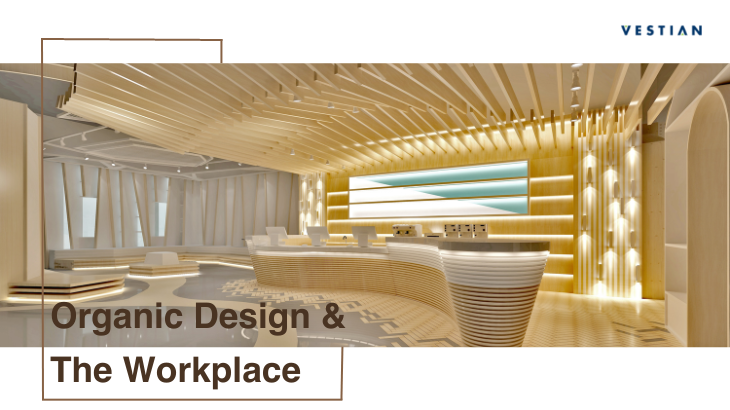Organic design is a non-conformist natural language that introduces organic environments indoors with contours, patterns, textures, or numerical arrangements.
It is yet another way of bringing nature indoors and enhancing wellbeing in a built space, contributing towards a more engaging and healthier workspace. An important aspect of organic design is the use of natural materials like wood, stone, and bamboo, that make the workspace more warmer and inviting. This is something that cannot be replicated with synthetic materials. Additionally, adding a water element to the mix, can help create a calm atmosphere and reduce stress levels. The sound of water also helps reduce noise levels and improve concentration.
A built environment with organic forms and patterns feels comfortable as it’s known to create a more visually attractive environment that enhances cognitive performance and reduces stress. Infact, over the years studies have shown that exposure to shapes does have a psychological effect on people, attributing to different emotions, thoughts and perceptions that resonate with the viewers’ mind. When it comes to incorporating organic designs in the workplace, there are a number of different techniques that can be used. One of the most effective techniques is to use nature as inspiration. This can be achieved through the use of furniture and architecture that has rounded edges and soft lines.
Organic designs can also incorporate biomorphic forms, like spirals, waves, and swirls, to create a sense of movement and flow at the workplace. These forms can further be incorporated into the design through furniture, architecture, or even artwork. Incorporating textures into the design, like rough stones or textured walls, helps bring a sense of nature indoors.
There is an undeniable link between certain shapes and the way we think, that when utilised can help promote certain attributes and behaviour. Infact today, companies are using AI tools that help optimize work processes, enhance creative assets and analyse customer preferences. One such tool analyses people’s movement at the workplace and accordingly, produces design layouts that cater to the needs of the employees. There are also AI tools that generate multiple design options which not only personalise the workplace design, but also improve user engagement.
Understanding the psychology of the most commonly used shapes
Squares and Rectangles are the most commonly used shapes in spatial designs and give viewers a sense of reliability and security, attributing people to feel safe and contained.
Triangles are dynamic shapes that represent motion and direction and a sense of movement in design.
Circles, Ovals and Ellipses are classic shapes in designs and often softer and milder than other shapes. They represent both unity and protection. Circular shapes are much friendlier forms as they tend to invite the viewers into their completeness.
Spirals designs represent creativity, the process of growth and evolution. Using spirals in the form of design also represents expansion and transformation. Spirals move in either right or left direction and represent returning to the same point in a journey with new levels of understanding. It also represents trust during change, the release of energy and maintenance of flexibility through transformation.
Vertical, Horizontal, Cross and Curves: While these shapes may look similar, they all represent different meanings. Cross shapes suggest transition, balance, faith, unity and hope. On the other hand, vertical shapes are seen as strong and horizontal shapes. Curved shapes are more feminine and sharp shapes represent energy, violence or anger. Sharp shapes are lively and youthful and are seen as more masculine.
Every element at the workplace contributes to the overall experience of the workplace and one cannot ignore them. It’s time to leverage on these insights and create a workplace that is welcoming and inclusive for all.

